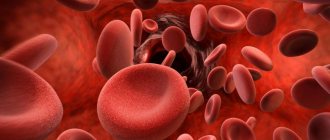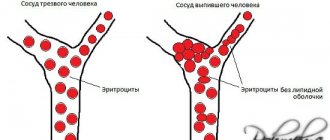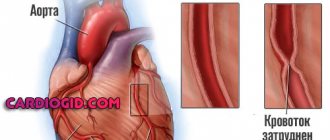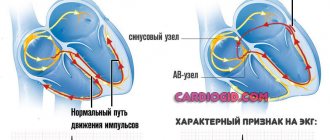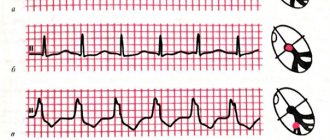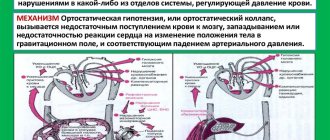Venous blood - what is it?
Venous – blood that returns to the heart and lungs from organs and tissues. It circulates through the pulmonary circulation. The veins through which it flows lie close to the surface of the skin, so the venous pattern is clearly visible.
This is partly due to a number of factors:
- It is thicker, rich in platelets, and if damaged, venous bleeding is easier to stop.
- The pressure in the veins is lower, so if a vessel is damaged, the amount of blood loss is lower.
- Its temperature is higher, so it additionally prevents rapid heat loss through the skin.
The same blood flows in both arteries and veins. But its composition is changing. From the heart it enters the lungs, where it is enriched with oxygen, which it transfers to the internal organs, providing them with nutrition. The veins that carry arterial blood are called arteries. They are more elastic, blood moves through them in spurts.
Arterial and venous blood do not mix in the heart. The first passes along the left side of the heart, the second - along the right. They are mixed only in case of serious heart pathologies, which entails a significant deterioration in well-being.
When to see a doctor
Contact a doctor immediately if any pathological signs are present. Don't ignore the following symptoms:
- nausea;
- vomit;
- weakness;
- loss of consciousness;
If you have severe abdominal pain, consult your doctor
- dizziness;
- itching and burning in the genitals;
- abundant black discharge or, conversely, excessively scanty;
- intense abdominal pain.
Delay and ignoring the doctor’s recommendations can lead to the development of complications.
Materials used in the article:
https://faqgurupro.ru/nauka/estestvennye-nauki/195502-pochemu-krov-temnaja.html
https://mesyachnie.com/informacija/chernaja-krov.html
https://medboli.ru/zabolevaniya/pochemu-bolit-pravyj-visok
Post Views: 91
What is the systemic and pulmonary circulation?
From the left ventricle, the contents are pushed out and enter the pulmonary artery, where they are saturated with oxygen. It is then distributed throughout the body through arteries and capillaries, carrying oxygen and nutrients.
The aorta is the largest artery, which is then divided into superior and inferior. Each of them supplies blood to the upper and lower parts of the body, respectively. Since the arterial system “flows around” absolutely all organs and is supplied to them with the help of a branched system of capillaries, this circle of blood circulation is called large. But the arterial volume is about 1/3 of the total.
Blood flows through the pulmonary circulation, which has given up all the oxygen and “taken away” metabolic products from the organs . It flows through the veins. The pressure in them is lower, the blood flows evenly. It returns through the veins to the heart, from where it is then pumped to the lungs.
What is venous blood rich in?
When the blood reaches the organs, it gives them oxygen, in return it is saturated with metabolic products and carbon dioxide, and acquires a dark red hue.
A large amount of carbon dioxide is the answer to the question why venous blood is darker than arterial blood and why veins are blue. It also contains nutrients that are absorbed in the digestive tract, hormones and other substances synthesized by the body.
Its saturation and density depend on which vessels the venous blood flows through. The closer to the heart, the thicker it is.
How to stop venous bleeding?
With minor damage to the veins of the extremities, it is often enough to create an artificial outflow of blood by raising an arm or leg above the level of the heart.
A tight bandage should be applied to the wound itself to minimize blood loss. If the injury is deep, a tourniquet should be placed above the damaged vein to limit the amount of blood flowing to the injury site.
In summer you can keep it for about 2 hours, in winter - for an hour, maximum one and a half. During this time, you need to have time to deliver the victim to the hospital. If you hold the tourniquet longer than the specified time, tissue nutrition will be disrupted, which threatens necrosis.
It is advisable to apply ice to the area around the wound. This will help slow down your blood circulation.
General information
For some reason, almost all people are sure that arterial blood is the type that flows in arterial vessels. In fact, this opinion is wrong. Arterial blood is enriched with oxygen, which is why it is also called oxygenated. It moves from the left ventricle to the aorta, then goes through the arteries of the systemic circulation. After the cells are saturated with oxygen, the blood turns into venous and enters the veins of the BC. In a small circle, arterial blood moves through the veins.
Different types of arteries are located in different places: some are deep in the body, while others allow you to feel the pulsation.
Venous blood moves through the veins into the CD and through the arteries into the MC. There is no oxygen in it. This liquid contains a large amount of carbon dioxide, decay products.
Function
Blood has specific and general functions. The latter include:
- nutrient transfer;
- transport of hormones;
- thermoregulation.
Venous blood contains a lot of carbon dioxide and little oxygen. This difference is due to the fact that oxygen enters only the arterial blood, while carbon dioxide passes through all vessels and is contained in all types of blood, but in different quantities.
Venous and arterial blood have different colors. In the arteries it is very bright, scarlet, light. The blood in the veins is dark, cherry-colored, almost black. This is related to the amount of hemoglobin.
When oxygen enters the blood, it enters into an unstable combination with the iron contained in red blood cells. Once oxidized, iron colors the blood bright red. Venous blood contains many free iron ions, which is why it becomes dark in color.
Causes of dark circles under the eyes
There is an opinion that fatigue, lack of sleep, and overexertion can change your appearance accordingly. But this lifestyle does not cause the appearance of black circles, it only makes the skin pale, which further emphasizes the blackness under the eyes. But poor nutrition, lack of vitamins and lack of rest together can negatively affect the skin around the eyes.
When talking to a person, you always look him in the eye. Noticing black circles on your interlocutor changes your impression of him. One gets the feeling that he is sick with something. This may be true. Impaired kidney function, cardiovascular diseases, and lack of oxygen can affect the color of the skin around the eyes. To correct this, cosmetic procedures will not help, the disease must be cured.
If you find black spots under your eyes, you should consult a doctor to determine the cause. This may be the first sign of a serious illness.
The culprit may be old age, which spares no one. The skin becomes thinner and blood vessels become more visible. And the older a person gets, the more the process gets worse. By identifying the cause of the appearance of black circles under the eyes, the doctor can diagnose a lack of iron in the blood.
To increase the level of iron in the blood, you need to eat right, eat more fresh fruits, vegetables and natural juices.
People who work a lot at the computer need to especially carefully monitor their vision, eyes and the condition of their skin. Severe overstrain of the visual organs is the cause of the appearance of circles under the eyes.
Blood movement
When wondering what the difference is between arterial blood and venous blood, few people know that these two types also differ in their movement through the vessels. In arteries, blood moves away from the heart, and through veins, on the contrary, towards the heart. In this part of the circulatory system, blood circulation is slow as the heart pushes fluid away from itself. Valves located in the vessels also affect the reduction in movement speed. This type of blood movement occurs in the systemic circulation. In the pulmonary circle, arterial blood moves through the veins. Venous - through the arteries.
Why is condensation dangerous?
Blood viscosity often increases in pregnant women. In this case, this process plays a natural role of protection against possible bleeding and miscarriage. Also, the fluid in the vessels of women becomes thicker immediately before childbirth. This is how nature protects the expectant mother from severe blood loss. But excessive thickening during pregnancy can be dangerous both for the woman (promotes thrombosis, thrombophilia, varicose veins, leukemia) and for the fetus (damage to the vascular bed).
As for newborns, their blood is much thicker than that of adults. But that shouldn't be a concern. The baby needs time to adjust to life in a new environment. In the first hours after birth, hemoglobin in the baby’s body can reach 200 g/l. But already in the first few days of life, these numbers will begin to decline. Almost half of the hemoglobin will be destroyed in the first day and the thickness of the baby’s blood will decrease.
It’s a different matter for adults whose blood has become thick for various reasons. They should not expect the indicators to return to normal on their own. This condition can be dangerous to health.
Often, thickening is accompanied by increased formation of blood clots, which can clog blood vessels, preventing normal blood flow. If a blood clot blocks a vessel in the heart or brain, a heart attack or stroke may occur, possibly with death.
If the substance has become viscous, but the number of platelets has decreased, this condition leads to circulatory problems in the body and increases the risk of bleeding. In some cases, hypercoagulability syndrome accompanied by a reduced platelet count is a symptom of cancer.
If increased viscosity is not treated, this condition can provoke hyperosmolar coma and intracerebral hemorrhage, which has a high risk of death.
Bleeding
When providing first aid, it is important to know which blood is arterial and which is venous. These species are easily identified by their flow patterns and color.
With arterial bleeding, a fountain of bright scarlet blood is observed. The liquid flows out pulsatingly and quickly. This type of bleeding is difficult to stop, which is the danger of such injuries.
When providing first aid, it is necessary to raise the limb and compress the damaged vessel by applying a hemostatic tourniquet or pressing it with finger pressure. In case of arterial bleeding, the patient must be taken to the hospital as quickly as possible.
Arterial bleeding may be internal. In such cases, a large amount of blood enters the abdominal cavity or various organs. With this type of pathology, a person suddenly becomes ill, the skin turns pale. After some time, dizziness and loss of consciousness begin. This is due to lack of oxygen. Only doctors can provide assistance with this type of pathology.
With venous bleeding, dark cherry-colored blood flows out of the wound. It flows slowly, without pulsation. You can stop this bleeding yourself by applying a pressure bandage.
Why do periods turn black?
Normally, monthly bleeding is red in color with a bright or dark tint. The color can reach burgundy. Almost black discharge is not normal. Often this is a sign of hormonal imbalance, the cause of which can only be determined by a doctor.
Only a doctor can determine the true cause of the present deviation after receiving the results of a comprehensive diagnosis. A one-time color change is often not a cause for concern. You need to visit a doctor if the symptom occurs regularly.
The causes of the condition can be both pathological and physiological. The blood turns black due to stagnation. This is likely when your period is late.
Circulation circles
There are three circles of blood circulation in the human body: large, small and coronary. All the blood flows through them, so if even a small vessel is damaged, severe blood loss can occur.
The pulmonary circulation is characterized by the release of arterial blood from the heart, passing through the veins to the lungs, where it is saturated with oxygen and returns back to the heart. From there it goes along the aorta in a large circle, delivering oxygen to all tissues. Passing through various organs, the blood is saturated with nutrients and hormones, which are carried throughout the body. In the capillaries there is an exchange of useful substances and those that have already been used. This is where oxygen exchange occurs. From the capillaries the fluid enters the veins. At this stage, it contains a lot of carbon dioxide, decay products. Through the veins, venous blood is carried throughout the body to organs and systems, where cleansing of harmful substances occurs, then the blood approaches the heart, passes into a small circle, where it is saturated with oxygen, giving off carbon dioxide. And everything starts all over again.
Venous and arterial blood should not mix. If this happens, it will reduce a person's physical capabilities. Therefore, in case of heart pathologies, operations are performed that help lead a normal life.
Both types of blood are important for the human body. During blood circulation, fluid changes from one type to another, ensuring the normal functioning of the body, as well as optimizing the functioning of the body. The heart pumps blood at tremendous speed, without stopping its work for a minute, even during sleep.
To properly help a person with bleeding, you need to know exactly how. For example, arterial and venous bleeding requires a special approach. Arterial and venous blood are different from each other.
What are the natural causes?
For physiological underlying causes, treatment is not necessary. Changing the color of menstruation is not a reason to worry. The main natural causes of darkening of menstruation are presented in the table.
| Recovery period after childbirth | Childbirth is a real stress for the female body. During pregnancy, hormonal levels change significantly for normal gestation. Menstruation temporarily stops. After the birth of a child, the mother’s body begins to recover. The first menstruation can begin as early as 4 months, depending on the chosen method of feeding the baby. Due to the enlargement of the uterus, the organ contracts worse. Blood stays in the uterus for some time. In this case, the normal shade will resume only after 3-5 cycles. |
| Climax | Also commonly called menopause, this is a natural state of the female body, which is caused by aging and the cessation of functioning of the ovaries. Menopause occurs most often after 45. With this age-related change, menstruation becomes less abundant. This is due to rapid hormonal changes. At first, menstruation will be irregular, and then completely disappear. During menopause, the cervical canal becomes narrower. This makes it difficult for the normal flow of blood from the genital tract. The iron in the composition begins to oxidize. The remains of the endometrium actively accumulate. Menses become blackish. |
| Taking medications | Dark menstruation is possible when taking hormonal medications, including contraceptives. These medications are taken to prevent the implantation of an egg. Prevents conception. For the first few months, your periods are irregular. The body adapts to new conditions. Adaptation occurs independently without outside intervention. |
| After an abortion | Abortion is stressful for the body. It takes some time to recover. Surgery injures the mucous membranes. The uterus is not able to fully contract. Menstruation leaves the body slowly and oxidizes. Long-term persistence of the symptom indicates the development of an inflammatory process. |
| Hysteroscopy | The procedure for inserting instruments through the vagina. This impairs muscle contractility and leads to darkening of menstruation. |
The listed reasons do not require treatment and should not cause concern in a woman. It takes some time to recover.
Taking hormonal pills can cause darkening of the discharge
What is arterial and venous blood
Blood in the human body passes through two circles - large and small. The large circle is formed by arteries, the small circle by veins.
Arteries and veins are connected to each other. Small arterioles and venules branch off from large arteries and veins. And they, in turn, are connected by the thinnest vessels - capillaries. They exchange oxygen for carbon dioxide and deliver nutrients to our organs and tissues.
Functions in the body
- Arterial blood carries oxygen, nutrients, and hormones throughout the body.
- Venous, unlike arterial, carries carbon dioxide from tissues to the lungs, metabolic products to the kidneys, intestines, and sweat glands. By folding, it protects the body from blood loss. Warms organs that need warmth. Venous blood flows not only through the veins, but also through the pulmonary artery.
Differences
- The color of venous blood is dark red with a bluish tint. It is warmer than arterial water, its acidity is lower, and its temperature is higher. There is no oxygen in her hemoglobin, carbhemoglobin. In addition, it flows closer to the skin.
- Arterial - bright red, saturated with oxygen and glucose. Oxygen in it is combined with hemoglobin to form oxyhemoglobin. The acidity is much higher than in the venous. It comes out to the surface of the skin on the wrists and at the neck. Flows much faster. That's why it's hard to stop her.
What color is the blood in the veins and what functions does it perform?
Do you know what color the blood in the veins is? The shade of biological fluid determines the presence of hemoglobin in red blood cells (erythrocytes). The blood circulating through the arteries, as already mentioned, is scarlet.
This is due to the high concentration of hemoglobin (in humans) and hemocyanin (in arthropods and mollusks), enriched with various nutrients.
Venous blood has a dark red tint. This is due to oxidized and reduced hemoglobin.
At the very least, it is unreasonable to believe the theory according to which the biological fluid circulating through the vessels is bluish in color, and when injured and in contact with air due to a chemical reaction, it immediately turns red. It is a myth.
Veins can only appear bluish, this is due to the simple laws of physics
. When light hits the body, the skin reflects some of all the waves and therefore looks light or dark (this depends on the concentration of the coloring pigment).
You know what color venous blood is, now let's talk about the composition. You can distinguish arterial blood from venous blood using laboratory tests. Oxygen tension - 38-40 mmHg. (in venous), and in arterial blood - 90. The content of carbon dioxide in venous blood is 60 millimeters of mercury, and in arterial blood - about 30. The pH level in venous blood is 7.35, and in arterial blood - 7.4.
The outflow of blood, carrying away carbon dioxide and products formed during metabolism, is carried out through the veins. It is enriched with useful substances that are absorbed into the walls of the gastrointestinal tract and produced by vital substances.
Now you know what color the blood is in the veins, you are familiar with its composition and functions.
Blood flowing through the veins overcomes “difficulties” during movement, which include pressure and gravity. That is why, in case of damage, biological fluid flows in a slow stream. But if the arteries are injured, blood spurts out like a fountain.
The speed at which venous blood moves is much less than the speed at which arterial blood moves. The heart pumps blood out under high pressure. After it passes through the capillaries and becomes venous, a decrease in pressure to ten millimeters of mercury is noted.
Signs of bleeding
First aid for bleeding is stopping or reducing blood loss before the ambulance arrives. It is necessary to distinguish between types of bleeding and correctly use the necessary means to stop them. It is important to have dressings in your home and car first aid kits.
The most dangerous types of bleeding are arterial and venous. The main thing here is to act quickly, but do no harm.
- During arterial bleeding, blood flows in bright scarlet intermittent fountains at high speed in time with the heartbeat.
- With venous, a continuous or weakly pulsating dark cherry stream of blood flows from the injured vessel. If the pressure is low, a blood clot forms in the wound and blocks the blood flow.
- With capillary, bright blood slowly spreads over the entire wound or flows in a thin stream.
Causes of black blood during menstruation
Menstruation is the “mirror” of the female reproductive system. By menstruation, you can determine whether the reproductive organs are functioning normally. Black blood during menstruation is not normal. This means that the discharge leaves the uterus with a delay. You should visit a doctor and determine the true cause of this change. The deviation does not always require treatment.
There can be many reasons for black periods
Sometimes black menstruation has physiological underlying causes. Self-medication is strictly prohibited and can be dangerous. Dark menstruation usually has a thick consistency and comes out with clots. Black color often appears during treatment with hormonal drugs.
